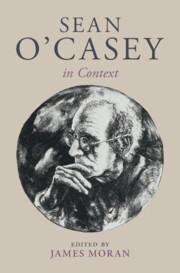Book contents
- Sean O’Casey in Context
- Sean O’Casey in Context
- Copyright page
- Contents
- Figures
- Tables
- Contributors
- Acknowledgements
- Sean O’Casey’s Life and Times: A Chronology
- Abbreviations
- Introduction
- Part I Key Places and Events
- Part II Social Contexts
- Chapter 6 Nationalism
- Chapter 7 Class
- Chapter 8 Censorship
- Chapter 9 Women
- Chapter 10 Gender and Sexuality
- Chapter 11 Disability
- Chapter 12 Race
- Chapter 13 Migration
- Chapter 14 Religion
- Chapter 15 Loss
- Part III Collaborators and Critics
- Part IV Performance Legacies
- Part V Non-Theatrical Writings
- Part VI Critical Understandings
- Further Reading
- Index
Chapter 15 - Loss
from Part II - Social Contexts
Published online by Cambridge University Press: 23 June 2025
- Sean O’Casey in Context
- Sean O’Casey in Context
- Copyright page
- Contents
- Figures
- Tables
- Contributors
- Acknowledgements
- Sean O’Casey’s Life and Times: A Chronology
- Abbreviations
- Introduction
- Part I Key Places and Events
- Part II Social Contexts
- Chapter 6 Nationalism
- Chapter 7 Class
- Chapter 8 Censorship
- Chapter 9 Women
- Chapter 10 Gender and Sexuality
- Chapter 11 Disability
- Chapter 12 Race
- Chapter 13 Migration
- Chapter 14 Religion
- Chapter 15 Loss
- Part III Collaborators and Critics
- Part IV Performance Legacies
- Part V Non-Theatrical Writings
- Part VI Critical Understandings
- Further Reading
- Index
Summary
In 2018 the ANU theatre company, which had gained a reputation for immersive performance and installation work since forming in 2009, staged a site-specific piece in Dublin called The Lost O’Casey. This play took inspiration from, and reimagined, key elements of Sean O’Casey’s 1924 play Nannie’s Night Out. This chapter, co-authored by the director of the ANU production and by a leading theatre historian, examines the social and political imperatives behind the 2018 production, and connects the concerns that O’Casey articulated in the 1920s with the endemic poverty, inequality, and losses of the modern Irish capital.
Information
- Type
- Chapter
- Information
- Sean O'Casey in Context , pp. 159 - 170Publisher: Cambridge University PressPrint publication year: 2025
Accessibility standard: Inaccessible, or known limited accessibility
Why this information is here
This section outlines the accessibility features of this content - including support for screen readers, full keyboard navigation and high-contrast display options. This may not be relevant for you.Accessibility Information
Content Navigation
Allows you to navigate directly to chapters, sections, or non‐text items through a linked table of contents, reducing the need for extensive scrolling.
Provides an interactive index, letting you go straight to where a term or subject appears in the text without manual searching.
Reading Order & Textual Equivalents
You will encounter all content (including footnotes, captions, etc.) in a clear, sequential flow, making it easier to follow with assistive tools like screen readers.
Visual Accessibility
You will still understand key ideas or prompts without relying solely on colour, which is especially helpful if you have colour vision deficiencies.
